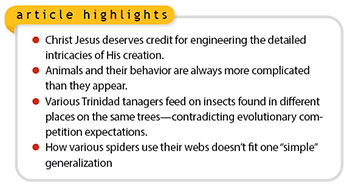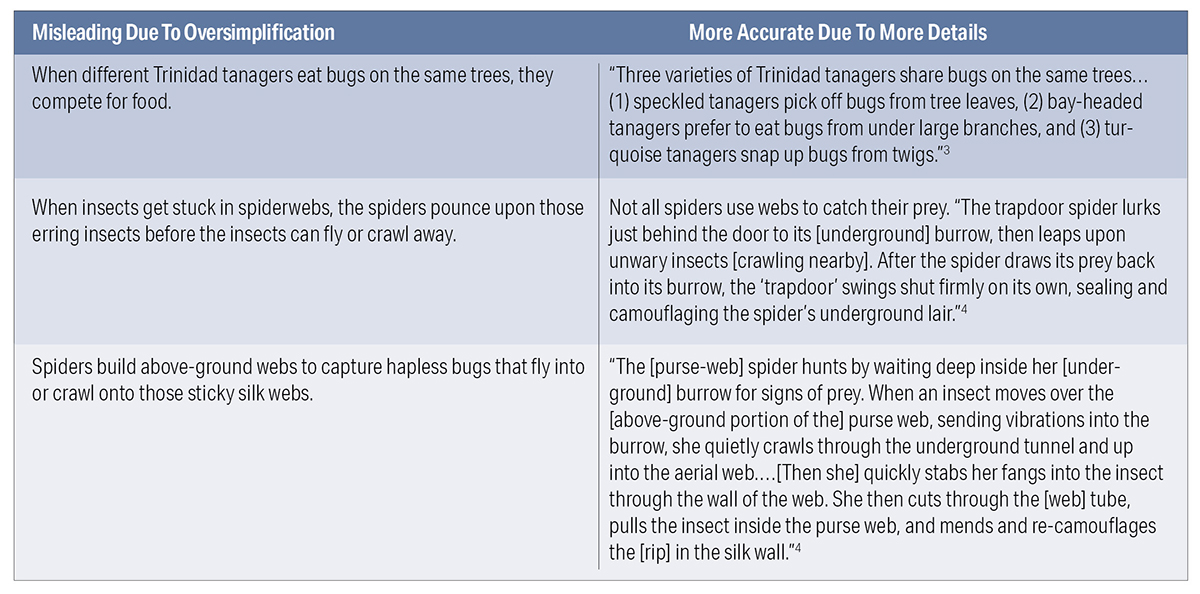 The Lord Jesus Christ deserves glory for why He made Earth’s diverse creatures, and He also deserves glory for the complicated details of how they live.
The Lord Jesus Christ deserves glory for why He made Earth’s diverse creatures, and He also deserves glory for the complicated details of how they live.
Although we cannot learn all of creation’s astounding details, the Lord enabled us to learn much of what He has done. The secret (literally “hidden”) things belong to the Lord our God, but those things which are revealed belong to us and to our children forever.1
God wants us to learn His revealed wonders beyond measure, but we must take the time necessary to see amazing details. Many of these details are exceptions to general trends.
The more details we learn about how animals live, the easier it is to recognize oversimplification fallacies—and overgeneralizations—that pervade evolutionist descriptions of animal life.
As Dr. Randy Guliuzza has documented, oversimplified descriptions misleadingly omit important details.2
So, how do animals actually live in the real world? Animal body systems and behaviors are always more complicated than they appear. There are no such things as “simple” life forms. This point can be illustrated by something as simple as eating bugs. Birds and spiders have bug-eating habits that are not as “simple” as you might expect.
Many more examples could be given, if space permitted. Don’t believe it when an evolutionist talks about “simple” life forms—life is always much more complicated than it appears.1

References
- Deuteronomy 29:29 (29:28 in biblical Hebrew numbering). The adjective “secret” (or “hidden”) derives from the Hebrew verb sâtar (meaning “to hide”). Wigram, G. V. 2001. The Englishman’s Hebrew Concordance to the Old Testament, 3rd ed. Peabody, MA: Hendricksen Publishers, 886. Originally published in 1874.
- “If you start looking for the word ‘simple’ in evolution-based education, you may be shocked at how often it is used. Simple changes made to simple creatures are more easily believed, but in real life biologically complex entities have many intricately arranged parts that are functionally interconnected to satisfy an intended purpose.” Guliuzza, R. J. 2010. Discovering Life’s Complex Patterns of Design. Acts & Facts. 39 (7): 10-11. Generally speaking, male birds sing seasonally, during springtime breeding; however, song sparrows also sing during summer months. Burke, M. 2021. If the Song Sparrow is Singing, It has to be Summer. Chesapeake Bay Journal. 31 (5): 47.
- Johnson, J. J. S. 2016. Tree-Snacking Tanagers Undermine Darwin. Acts & Facts. 45 (6): 21.
- Shipman, W. 1994. Animal Architects: How Animals Weave, Tunnel, and Build their Remarkable Homes. Mechanicsburg, PA: Stackpole Books, 33 (trapdoor spider), 38 (purse-web spider).
* Dr. Johnson is Associate Professor of Apologetics and Chief Academic Officer at the Institute for Creation Research.




